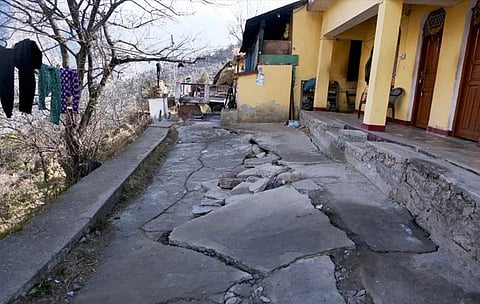
- HOMEGROWN WORLD
- #HGCREATORS
- #HGEXPLORE
- #HGVOICES
- #HGSHOP
- CAREERS
- ABOUT US
- CONTACT US

I am sure all of us know about climate change and about the adverse effects of human intervention with nature but we have all been guilty of at least thinking once at the back of our heads, if not out loud, that no disaster will befall our generation— maybe the next or the generation after. Guess what? We are all at the precipice of history, when all the decades of warnings by environmentalists and climate change activists are coming true. We don’t have to look as far as the melting polar ice caps but something much closer to home — the sinking Himalayan town of Joshimath in Uttarakhand.
Joshimath is a quaint town and the gateway to several Himalayan mountain climbing expeditions, trekking trails, and pilgrim centers such as Badrinath. The town is on the edge as it keeps sinking with each passing day. An air of panic has sweeped through the residents of the town as cracks have begun to form in their homes because of the displacement of underground earth layers. Despite this, the Government body National Disaster Management Authority (NDMA) is trying its best to keep mum about the situation and is asking scientific institutions not to talk to the media about the situation in Joshimath as it may cause major panic. A preliminary report by the Indian Space Research Organisation’s National Remote Sensing Centre, showing a “rapid subsidence” event in parts of Joshimath, was even taken down.
But the main question that props up is how did we reach a stage where we are having to refer to a place as the “sinking town of Joshimath.” The answer is fairly simple — years and years of negligence. The site of the current disaster is a major military and administrative hub and the state-run NTPC is working on a huge hydroelectric power project there. Despite warnings by environmentalists and activists highlighting the dangers posed to the region and the fragile ecosystem of the nearby mountain ranges, the town has seen rapid developments of dams, roads, and military sites.
"Joshimath is not suitable for a township", the government-appointed Mishra Committee report had warned in 1976 and recommended a ban on heavy construction work in the area yet the warning was paid no heed. Unchecked construction, use of explosives for drilling, and digging of tunnels before construction have weakened the slopes and disrupted the natural course of things in an already high-risk seismic zone. Cracks have developed in nearly 850 buildings, including a temple and the Auli Ropeway, as well as on pavements and streets. An estimated 165 buildings are currently in the danger zone. Some hotels now even lean on each other. Over 600 people from 145 families have so far been shifted to hotels, schools, and gurudwaras for their safety.
“The villages and townships in the northern part of Uttarakhand are located among the major active thrust zones within the Himalayas and are very senstitive because of the fragile ecosystem of the region. If you do a lot of mechanical activities in the region, the land will be prone to slide. This whole area is vulnerable to subsidence."
Rajeev Upadhyay, professor of Geology at the Kumaun University in Nainital
Uttarakhand has a dark long history of natural disasters. Earthquakes, landslides, cloud bursts, and flash floods have taken thousands of lives in the past. If we do not act judiciously with a climate-conscious mindset, Joshimath might be the first of many disasters to befall us.
If you enjoyed reading this article, we suggest you also read:
5 Questions About India's Natural Disaster Management Capabilities, Answered
Building A Sustainable Life With Climate Change On The Horizon
Why Do Forests In Mizoram Catch Fire During The Summer Season?
